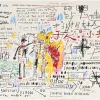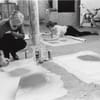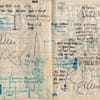Whether for galleries, exhibitions, or your portfolio website, an artist bio is a valuable asset that introduces your creative career and provides context to curators, viewers, or potential buyers. Besides the artist statement the first person, the bio is written in the third person and tells how you evolved as an artist, your accomplishments, credentials, and your creative journey. The statement and bio complement each other and form a complete picture of your work and personality, creating a sense of trust and connectivity with the reader.
To craft a compelling artist bio, we can use techniques and tools from professional wordsmiths. After all, authors and copywriters are experts in selecting words that work.
One go-to resource for every professional selling with words is “The Copywriter’s Handbook by Robert” W. Bly. While the author doesn’t specifically detail how to write an artist bio, it offers numerous principles for compelling copywriting that we can apply to the artist bio. Here are some key principles from the book, followed by examples generated with the help of Open AI’s GPT-4 to illustrate.
Know Your Audience
Before you write your bio:
- Consider who will read it. If you write it for a specific gallery exhibition, for example, you might want to attract potential buyers. Your artist bio is never set in stone but changes depending on the occasion and the audience.
- Put yourself in their shoes.
- Remember buyers from the past and what they said about your art. Why did it appeal to them?
Engage Immediately
The first two sentences of your bio decide if potential buyers will continue until the end. So, it’s crucial to engage them from the get-go. Start with a hook: Introduce a question or conflict that defines your artistic work. To get a basic idea, here are two rough examples:
- Is it possible for discarded materials to carry hidden stories waiting to be retold? Laura Whitmore believes so. Every forgotten photograph, frayed piece of cloth, or rusted key has a memory of the past within it.
- Do coffee stains become planets or mysterious galaxies in your imagination? For digital illustrator Nina Hayashi, everyday spills and splotches are the start of her cosmic adventures on digital canvas.
Amplify Benefits over Features
One golden copywriter rule is always to translate features into benefits. Benefits speak directly to the emotional needs or desires of the reader. They answer the question, “What’s in it for me?” This emotional resonance is far more persuasive than simply listing features. Let’s take a look at an example to clarify:
Focus on features:
Alice Williams is a professional photographer who specializes in landscape photography. She uses a Canon 5D Mark IV and has been published in National Geographic, Time Magazine, and The Guardian. She’s traveled to over 50 countries to capture her shots.
Focus on benefits:
Alice Williams offers viewers a ticket to unseen corners of our world. Her lens reveals the breathtaking beauty of landscapes that most can only dream of. Published in renowned media outlets like National Geographic, Alice doesn’t just take photos; she crafts stories of nature and culture, making viewers feel as if they’ve traveled to over 50 countries with her.
Use Clear, Simple Language
Especially when falling into the trap of using the so-called International Art English, a lot of text that appears in museum press releases or gallery exhibitions sounds rather pretentious than engaging. Clear and concise language helps you better communicate your ideas and values to connect with your audience.
Artspeak-Example:
"In Alexander Smith’s latest oeuvre, there’s an undeniable juxtaposition of postmodern disillusionment with the pre-Raphaelite celebration of nature. The ephemeral quality of his brushwork, combined with a chiaroscuro technique, evokes a dichotomy between the ephemeral and the eternal. "
Simple language:
From the first brushstroke, Jane Smith transports you directly into the serene countryside or chaotic cityscapes. With each painting, you don’t just see a location—you experience it. Jane doesn’t merely showcase her technique; she delivers a passionate visual journey inspired by her global travels.
Be specific
Specific information and facts are more credible than vague language. By stating numbers and details, you capture the reader’s attention. For example:
“Jane has showcased her work in over 20 international galleries, including the Louvre and the Metropolitan Museum of Art,” is more convincing than “Jane has showcased her art in various galleries.”
Use active tense
Many writing guides and styles, especially in journalism and academic writing, encourage active voice over passive voice, as it benefits the clarity and conciseness of your artist bio. It also fosters a more dynamic rhythm and speaks directly to the reader.
Passive voice:
Born in the coastal town of Riverview, artistic passion was discovered early by Alex Gray. A rich tapestry of marine life and sun-bleached landscapes are portrayed in his artworks.
Active voice:
Born in the coastal town of Riverview, Alex Gray discovered his artistic passion early on. His artworks portray a rich tapestry of marine life and sun-bleached landscapes.
Provide a call to action
Finally, close with a call to action. What do you want your readers to do? Visit your gallery exhibition? Get in touch on social media? Check out your portfolio website? Tell them the next steps. For example:
Experience the world through Aria’s eyes. Visit her latest exhibition, “Whispers in Color,” now at the Genesis Gallery until December 15th.
Artist bio example from start to finish
Engage Immediately:
Since her childhood in Barcelona, Aria Mendez has been spellbound by the world around her. Every street corner, every shadow, every forgotten artefact became a canvas for her imagination.
Show Benefits:
Her artwork isn’t just to be gazed upon; it’s an invitation. Viewers don’t just see her art—they experience it. It connects, evokes emotion, and provokes thought, turning passive onlookers into engaged participants.
Use Clear, Simple Language:
Aria paints, but she tells stories more than that. With each stroke, a tale unfolds, capturing moments, emotions, and memories.
Offer Specifics:
Having showcased in over 40 exhibitions globally, Aria has left her mark from the Tate Modern in London to the Museum of Modern Art in New York. Her signature style—a blend of realism infused with abstraction—has earned her numerous accolades, including the Prestigious Art Innovator Award in 2022.
Provide a Call to Action:
Experience the world through Aria’s eyes. Visit her latest exhibition, “Whispers in Color,” now showing at the Genesis Gallery until December 15th.
This text was created in collaboration with Open AI’s GPT-4.




